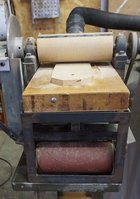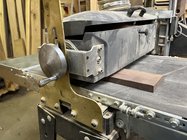Odd woman or not, your response is EXACTLY what I was looking for. I’m retired/disabled and don’t have an extra $1000 just laying around for a drum sander. I’m considering trying segmented turning but wanted to look for alternatives to shelling out money for the sander. I know I’m responding to something you posted about a decade earlier but hopefully you’re still around (and still turning) and wanted to say thank you for comment.OK, as the "oddwoman-out" here, I do have many yrs of experience with segmentations. First you need no sander..really. On your lathe make a 12 inch disc ( or the limit of your lathe)with sandpaper...take your glue-ups and flatten the bottom..then glue to your segmentation. Now, after that is dry, & if it is real lumpy, use a turning tool to flatten it. (if it is real lumpy, you need more skill glueing up) If not real lumpy, use a nice 3-4 inch wide board, longer than your project is in diameter,apply sticky backed sandpaper, and use it to and sand . You have now spend $2.00. This process has worked for me for decades.
Now that being said..a sander that you wish to buy is a great tool for a shop. If you can afford one, buy one.
-
December 2025 Turning Challenge: Single Tree! (click here for details) -
Congratulations to Bob Henrickson, People's Choice in the November 2025 Turning Challenge (click here for details) -
Congratulations to Steven Gordon for "Dropped Ice Cream Cone" being selected as Turning of the Week for December 8, 2025 (click here for details) -
Welcome new registering member. Your username must be your real First and Last name (for example: John Doe). "Screen names" and "handles" are not allowed and your registration will be deleted if you don't use your real name. Also, do not use all caps nor all lower case.
You are using an out of date browser. It may not display this or other websites correctly.
You should upgrade or use an alternative browser.
You should upgrade or use an alternative browser.
Drum sander for segmented turning
- Thread starter Mark Hepburn
- Start date
John,
Check out the post on disk sanders. Some are used on the lathe. Just like the post indicated I flatten one surface on the disc and then add to exiting base. I use a cone on the tail end to center the just flattened ring to the base. When glue is cured you turn the top side and flatten it with a long board and sand paper across the diameter of ring while lathe is running. Repeat for each ring. Not as quick as a stacked assembly but works.
Check out the post on disk sanders. Some are used on the lathe. Just like the post indicated I flatten one surface on the disc and then add to exiting base. I use a cone on the tail end to center the just flattened ring to the base. When glue is cured you turn the top side and flatten it with a long board and sand paper across the diameter of ring while lathe is running. Repeat for each ring. Not as quick as a stacked assembly but works.
I'm late to the party here and this may have been mentioned but here is an option. The Flat master drum sander. I've been using mine for a couple years now and it works real well for segmented disks as well as many other items. Not a thickness sander but a flat sander and the second side can be turned flat after it's on the lathe. Oh, and it's half what most drum sanders cost. Made in Canada.
Here
Here
Not Doug, but if I may. Have used mine for a couple years now (this thread reminds me I need to make more segmented bowls) and it really does get the rings flat. Not a thickness sander, but the rings can be very flat. It doesn't take off a lot at one time so several passes are needed but very simple to use. I use it on cutting boards as well as other things I need a flat surface.Doug, how would you say it is to use as compared with other sanders?
I know I have seen set ups for a drum sander for the wood lathes. It looks like it would work, though it doesn't have the feed/drive belt on the bottom, and that really helps. You may have a friend who has one and would let you use it, complete with instructions. I don't consider them to be good dimensioning machines, but fine for touch up work.
robo hippy
robo hippy

This is a drum sander that I made from plans in a model airplane magazine in the late 1960's. The intended purpose was to mill your own balsa sheets which I did some of but it works for just about any wood. The drum was sized to use a standard sheet of sand paper and yes it does thump but it doesn't appear to be a problem. The work piece is pushed thru with another board, which can be cut to the contour of the work piece such as a segmented ring. I used the machine up until about 5 years ago when I sprung for a 16" open sided (16/32) drum sander. The sander has been put aside ,but it still works.
The open sided sander presented it's own problem due to the fact that as soon as you start a piece in the sander the outboard end flexes so you don't get a parallel piece., so I had to contrive a clamping mechanism to eliminate that problem.
Russ Braun
TOTW Team
John,
A drumsander is not a requirement to do segmenting. It is a luxury that allows for more complex segmented pieces to be made. While I love mine and use it often, I spent 10years segmenting without one. I suggest you get one when a deal shows up, you won’t be disappointed.
A drumsander is not a requirement to do segmenting. It is a luxury that allows for more complex segmented pieces to be made. While I love mine and use it often, I spent 10years segmenting without one. I suggest you get one when a deal shows up, you won’t be disappointed.
Hey Russ, you better not tell that to my wifeJohn,
A drumsander is not a requirement to do segmenting. It is a luxury that allows for more complex segmented pieces to be made. While I love mine and use it often, I spent 10years segmenting without one. I suggest you get one when a deal shows up, you won’t be disappointed.
By now you've most likely committed to a drum sander if that is what you ended up deciding. I would just say that, while you don't have to have a drum sander, it sure makes things easier, I think. I haven't done much segmented turning, but have done some turning where I've glued layers together. For me there is nothing that beats a drum sander for flattening; especially smaller pieces. Plus, if you are a woodworker who does other woodworking besides turning (like furniture, cabinets; or you do any work where you resaw veneer (like 1/32" or thicker), there is nothing better than being able to run the veneer slice through a drum sander and get it smooth and flat.
I own a SuperMax 16-32 and love it! While it isn't my most used tool, it is one of the tools I'm glad I have when I need it.
I own a SuperMax 16-32 and love it! While it isn't my most used tool, it is one of the tools I'm glad I have when I need it.
Russ Braun
TOTW Team
I’m not talking to mine, why would I talk to yours, lol!!Hey Russ, you better not tell that to my wife.
Much can be done with a sharp jointer hand plane. I have a 27” wide power-fed drum sander that I built, but more often run segment rings through my planer on a piece of plywood.
Tim
Tim
Actually if you add the motor which is required and a fence and sandpaper the cost is approaching $1,200!!I'm late to the party here and this may have been mentioned but here is an option. The Flat master drum sander. I've been using mine for a couple years now and it works real well for segmented disks as well as many other items. Not a thickness sander but a flat sander and the second side can be turned flat after it's on the lathe. Oh, and it's half what most drum sanders cost. Made in Canada.
Here
Hum! When I bought my "Supermax 16/32: about 4 years ago I paid $1,100.00 new recently I went onto Laguna's web site and see that the current new price is around $1,300 and every thing was there.Actually if you add the motor which is required and a fence and sandpaper the cost is approaching $1,200!!
I was talking about the FlatMaster sander Denny suggested.Hum! When I bought my "Supermax 16/32: about 4 years ago I paid $1,100.00 new recently I went onto Laguna's web site and see that the current new price is around $1,300 and every thing was there.
agree 100% I bought (built) my flat master specifically for segmented turnings. but, although I moved on from segmenting after a few years, I've found it's perfect for a myriad of uses. I love it and couldn't do without it.I'm late to the party here and this may have been mentioned but here is an option. The Flat master drum sander. I've been using mine for a couple years now and it works real well for segmented disks as well as many other items. Not a thickness sander but a flat sander and the second side can be turned flat after it's on the lathe. Oh, and it's half what most drum sanders cost. Made in Canada.
Here
Is it safe to assume you have upgraded your thickness planer with carbide cutters or are you using the standard blades?Much can be done with a sharp jointer hand plane. I have a 27” wide power-fed drum sander that I built, but more often run segment rings through my planer on a piece of plywood.
Tim
Yes I know but the conventional drum sander is far superior so why pay more for an inferior product.I was talking about the FlatMaster sander Denny suggested.
18” Rockwell wedge bed with conventional head. Why would you assume otherwise?Is it safe to assume you have upgraded your thickness planer with carbide cutters or are you using the standard blades?
Tim
Only because most folks seem to scoff at the thought of sending segmented rings through the thickness planer. It intrigued me when reading what you said and if you are having success without any of the things that folks warn about, I'm interested how you're doing it. I had seen several posts of success with thickness planers using carbide cutters as opposed to conventional blades.18” Rockwell wedge bed with conventional head. Why would you assume otherwise?
Tim
Would you mind showing your technique? If you'd rather, feel free to message me directly.
Thanks,
John

